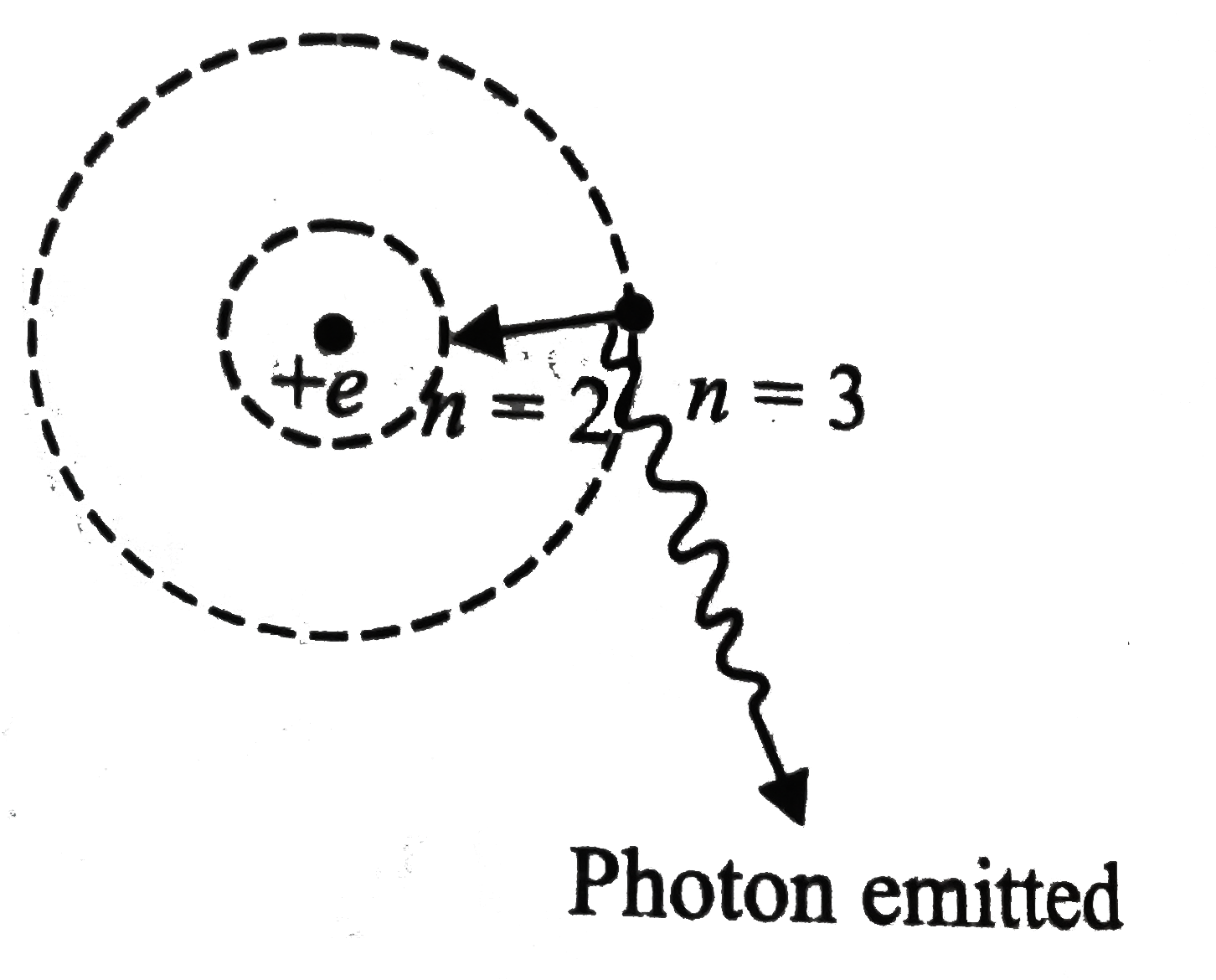A single electron orbits a stationary nucleus of charge +Ze, where Z is a constant and e is the magnitude of electronic charge . It requires 47.2eV to excite . Find
a the value of Z
b the energy required to excite the electron from the third to the fourth Bohr orbit.
the wavelength of electromagnetic rediation required to remove the electron from the first Bohr orbit to infinity.
d Find the KE,PE, and angular momentum of electron in the first Bohr orbit.
the redius of the first Bohr orbit
[The ionization energy of hydrogen atom =13.6eV Bohr radius =5.3×10_11m, "velocity of light" =3×10−8jms−1, Planck's constant =6.6×10−34j−s]
The energy required to excite the electron from n1→n2 orbit revolving round the nucleus with charge +Ze is given by
En_(2)−En_(1)=Z2×13.6[1n21−1n22] electron volt.
a. Since 47.2=eV energy is required to excite the electron from n1=2 to n2=3 orbit, therefore.
47.2=Z2×13.6[122−132]
⇒Z2=47.2×3613.6×5=25orZ=5
b. The energy is required to excite the electron from n1=3 to n2=4 orbit, therefore.
E4−E3=25×13.6×[132−142]=25×13.6×7144
=16.53eV<br>c.Thee≠rgyisrequired→removethee≤ctronomthefirstBohrorbit→∈f∈ity(oo)isgivenby<br>E_(oo) - E_(1) = 13.6 xx Z^(2) [(1)/(1^(2)) - (1)/(oo^(2))]=13.6×25eV
In order to calcalate the wevelength of radition, we use Bohr orbit frequncy relation
hf=hcλ=13.6×25×(1.6×10−19)j
or λ=6.6×1034×3×10813.6×25×(1.6×10−19)=36.5Å
d. KE=−Totle≠rgy=−(−13.6×52)×1.6×10−19j
PE = - 2 xx KE = - 2 xx 5.44 xx 10^(-17) = 10.88 xx 10^(-17)j<br>Anga––rμmentum= m v_(1) r_(1) = h// 2 pi = 1.05 xx 10^(-13)j s<br>e.Theradiusr_(1)ofthefirstBohr'sorbitisgivenby<br>r_(1) = (epsilon_(0) h^(2))/(pi me^2)(1)/(Z) = (0.53 xx 10^(-10))/(5) = 0.106 xx 10^(-10)m<br>= 0.106 Å<br>( :' (epsilon_(0) h^(2))/(pi me^2) = 0.53 xx 10^(-10))
Topper's Solved these Questions
- BOOK - CENGAGE PHYSICSCHAPTER - ATOMIC PHYSICSEXERCISE - Solved Examples23videos
ATOMIC PHYSICS
- BOOK - CENGAGE PHYSICSCHAPTER - ATOMIC PHYSICSEXERCISE - Exercise 4.115videos
ATOMIC PHYSICS
- BOOK - CENGAGE PHYSICSCHAPTER - ALTERNATING CURRENTEXERCISE - QUESTION BANK65videos
ALTERNATING CURRENT
- BOOK - CENGAGE PHYSICSCHAPTER - ATOMSEXERCISE - QUESTION BANK40videos
ATOMS
Similar Questions
A single electron orbits around a stationary nucleus of charge +Ze, where Z is a constant and e is the electronic charge. It requires 47.2eV to excited the electron from the second Bohr orbit to the third Bohr orbit. Find (i) the value of Z, (ii) the energy required to excite the electron from the third to the fourth Bohr orbit and (iii) the wavelength of the electromagnetic radiation radiation to remove the electron from the first Bohr orbit to infinity.
View SolutionA single electron orbikt around a stationary nucleus of charge +Ze when Z is a constant and e is the magnitube of the electronic charge if 47.2eVexcitethee≤ctronomthesecondbohrorbit→thethirdbohhrorbitf∈al<br>(i)ThevolueofZ<br>(ii)Tyhee≠rgyrequiredtoνc≤usthee≤ctronomthethird→thefourthbohrorbit<br>(iii)Thewave≤n>hofthee≤ctronmag≠ticradiationrequired→removethee≤ctronomthefirstbohrorbit→∈l∈ity<br>(iv)Thee≠rgypotentiale≠rgypotentiale≠rgyandtheanga––rmomentumofthee≤ctron∈thefirstbohrorbit<br>(v)Theradiusofthefirstbohrorbit(Theionizatione≠rgyofhydro≥na→m = 13.6 eV bohrradius= 5.3 xx 10^(-11) matrevelocityoflight= 3 xx 10^(8) m//secplanks'sconstant = 6.6 xx 10^(-34) jules - sec )
View Solution
Knowledge Check
- Question 1 - Select One
The ratio of the energy required to remove an electron from the first three Bohr's orbit of Hydrogen atom is
A3:2:1B9:4:1C36:9:4D1:4:9 - Question 2 - Select One
the energy required to excite an electron in hydrogen atom to its first excited state is
A8.5eVB10.2eVC12.7eVD13.6eV - Question 3 - Select One
Energy required for the electron excitation in Li++ from the first to the third Bohr orbit is
A36.3eVB108.8eVC122.4eVD12.1eV
A single electron orbits around a stationary nucleus of charge +Ze, where Z is a constant and e is the magnitude of the electronic charge. It requires 47.2eV to excite the electron from second Bohr orbit to the third bar Bohr orbit. Find :
(a) the value of Z,
(b) the energy required to excite the electron from n=3 to n=4.View SolutionA single electron orbits around a stationary nucless of charge +Ze where Z is a constant and e is the magnitude of electronic charge ,if respuires 47.2 e

is excite the electron from the second bohr orbit to the third bohr orbit
a. Find the value of Z
b. Find the energy required to the electron from n=3 ton=4
c. Find the wavelength of radiation to remove the electron from the second bohr orbit to infinity
d. Find the kinetic energy potential energy and angular momentum of the electron in the first orbit
Find the ionination energy of above electron system in electronvalt.View SolutionDetermine the wavelength of the radiation required to excite the electron in Li++ from the first to the third Bohr orbit.
View SolutionAn energy of 68eV is required to excite a hydrogen like atom from its second Bohr orbit to the third. The nuclear charge is Ze. Find the value of Z, the kinetic energy of the electron in the first Bohr orbit and the wavelength of the radiation required to eject the electrons from the first Bohr orbit to infinity.
View SolutionAn energy of 68.0 eV is required to excite a hydrogen-like atom in its second Bohr orbit to third. The nuclear charge is Ze. Find the value of Z, the kinetic energy of the electron in the first Bohr orbit and the wavelength of the electronmagnetic radiation required to eject the electron from the first orbit to infinity.
View Solution

